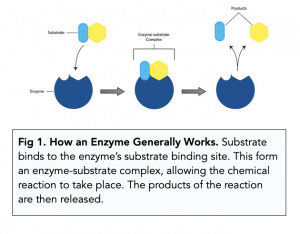Enzymes: Introduction (A-level Biology)
Enzymes: Introduction
Introduction to the Structure and function of enzymes
- Enzymes reduce the activation energy of a reaction. Enzymes are globular proteins which reduce the activation energy of a chemical reaction by binding directly to one or more substrates (targets).
- Activation energy is the minimum amount of energy required for a collision between two particles to result in a reaction.
- Reducing the Ea of a reaction increases the rate at which the reaction occurs. In many instances, chemical reactions in the body require a higher temperature than normal body temperature. Reduction of Ea by enzymes allows for these reactions to occur at lower temperatures and at a greater rate.
- Most enzymes are capable of binding only a very unique substrate. Therefore, the shape of an enzyme directly impacts and determines its biological function.
- Enzymes usually have an almost spherical shape. Enzymes can be large, or they can be compact, depending on the substrates to which they bind.
- Enzymes are usually soluble in water. This means that they have a large number of polar (hydrophilic) amino acids in their polypeptide chains.






Still got a question? Leave a comment
Leave a comment